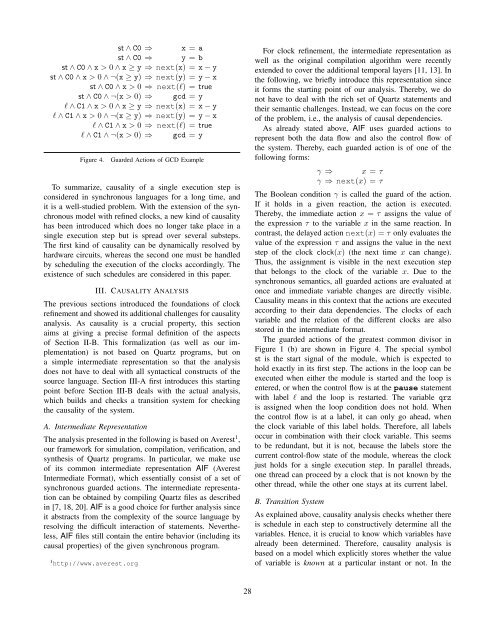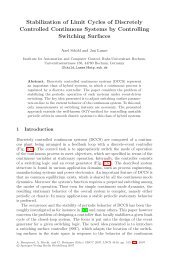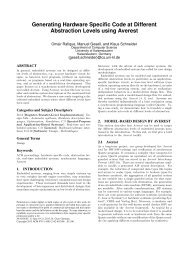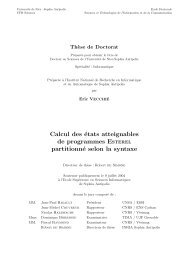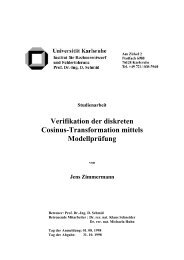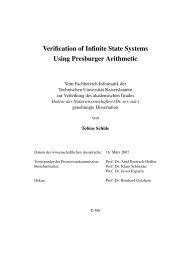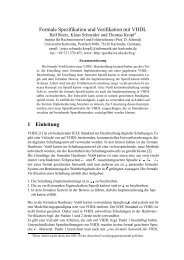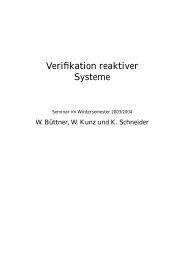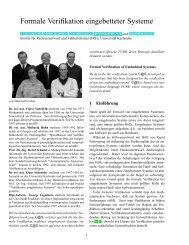Causality Analysis of Synchronous Programs with Refined Clocks
Causality Analysis of Synchronous Programs with Refined Clocks
Causality Analysis of Synchronous Programs with Refined Clocks
You also want an ePaper? Increase the reach of your titles
YUMPU automatically turns print PDFs into web optimized ePapers that Google loves.
st ∧ C0 ⇒ x = a<br />
st ∧ C0 ⇒ y = b<br />
st ∧ C0 ∧ x > 0 ∧ x ≥ y ⇒ next(x) = x − y<br />
st ∧ C0 ∧ x > 0 ∧ ¬(x ≥ y) ⇒ next(y) = y − x<br />
st ∧ C0 ∧ x > 0 ⇒ next(l) = true<br />
st ∧ C0 ∧ ¬(x > 0) ⇒ gcd = y<br />
l ∧ C1 ∧ x > 0 ∧ x ≥ y ⇒ next(x) = x − y<br />
l ∧ C1 ∧ x > 0 ∧ ¬(x ≥ y) ⇒ next(y) = y − x<br />
l ∧ C1 ∧ x > 0 ⇒ next(l) = true<br />
l ∧ C1 ∧ ¬(x > 0) ⇒ gcd = y<br />
Figure 4.<br />
Guarded Actions <strong>of</strong> GCD Example<br />
To summarize, causality <strong>of</strong> a single execution step is<br />
considered in synchronous languages for a long time, and<br />
it is a well-studied problem. With the extension <strong>of</strong> the synchronous<br />
model <strong>with</strong> refined clocks, a new kind <strong>of</strong> causality<br />
has been introduced which does no longer take place in a<br />
single execution step but is spread over several substeps.<br />
The first kind <strong>of</strong> causality can be dynamically resolved by<br />
hardware circuits, whereas the second one must be handled<br />
by scheduling the execution <strong>of</strong> the clocks accordingly. The<br />
existence <strong>of</strong> such schedules are considered in this paper.<br />
III. CAUSALITY ANALYSIS<br />
The previous sections introduced the foundations <strong>of</strong> clock<br />
refinement and showed its additional challenges for causality<br />
analysis. As causality is a crucial property, this section<br />
aims at giving a precise formal definition <strong>of</strong> the aspects<br />
<strong>of</strong> Section II-B. This formalization (as well as our implementation)<br />
is not based on Quartz programs, but on<br />
a simple intermediate representation so that the analysis<br />
does not have to deal <strong>with</strong> all syntactical constructs <strong>of</strong> the<br />
source language. Section III-A first introduces this starting<br />
point before Section III-B deals <strong>with</strong> the actual analysis,<br />
which builds and checks a transition system for checking<br />
the causality <strong>of</strong> the system.<br />
A. Intermediate Representation<br />
The analysis presented in the following is based on Averest 1 ,<br />
our framework for simulation, compilation, verification, and<br />
synthesis <strong>of</strong> Quartz programs. In particular, we make use<br />
<strong>of</strong> its common intermediate representation AIF (Averest<br />
Intermediate Format), which essentially consist <strong>of</strong> a set <strong>of</strong><br />
synchronous guarded actions. The intermediate representation<br />
can be obtained by compiling Quartz files as described<br />
in [7, 18, 20]. AIF is a good choice for further analysis since<br />
it abstracts from the complexity <strong>of</strong> the source language by<br />
resolving the difficult interaction <strong>of</strong> statements. Nevertheless,<br />
AIF files still contain the entire behavior (including its<br />
causal properties) <strong>of</strong> the given synchronous program.<br />
1 http://www.averest.org<br />
For clock refinement, the intermediate representation as<br />
well as the original compilation algorithm were recently<br />
extended to cover the additional temporal layers [11, 13]. In<br />
the following, we briefly introduce this representation since<br />
it forms the starting point <strong>of</strong> our analysis. Thereby, we do<br />
not have to deal <strong>with</strong> the rich set <strong>of</strong> Quartz statements and<br />
their semantic challenges. Instead, we can focus on the core<br />
<strong>of</strong> the problem, i.e., the analysis <strong>of</strong> causal dependencies.<br />
As already stated above, AIF uses guarded actions to<br />
represent both the data flow and also the control flow <strong>of</strong><br />
the system. Thereby, each guarded action is <strong>of</strong> one <strong>of</strong> the<br />
following forms:<br />
γ ⇒ x = τ<br />
γ ⇒ next(x) = τ<br />
The Boolean condition γ is called the guard <strong>of</strong> the action.<br />
If it holds in a given reaction, the action is executed.<br />
Thereby, the immediate action x = τ assigns the value <strong>of</strong><br />
the expression τ to the variable x in the same reaction. In<br />
contrast, the delayed action next(x) = τ only evaluates the<br />
value <strong>of</strong> the expression τ and assigns the value in the next<br />
step <strong>of</strong> the clock clock(x) (the next time x can change).<br />
Thus, the assignment is visible in the next execution step<br />
that belongs to the clock <strong>of</strong> the variable x. Due to the<br />
synchronous semantics, all guarded actions are evaluated at<br />
once and immediate variable changes are directly visible.<br />
<strong>Causality</strong> means in this context that the actions are executed<br />
according to their data dependencies. The clocks <strong>of</strong> each<br />
variable and the relation <strong>of</strong> the different clocks are also<br />
stored in the intermediate format.<br />
The guarded actions <strong>of</strong> the greatest common divisor in<br />
Figure 1 (b) are shown in Figure 4. The special symbol<br />
st is the start signal <strong>of</strong> the module, which is expected to<br />
hold exactly in its first step. The actions in the loop can be<br />
executed when either the module is started and the loop is<br />
entered, or when the control flow is at the pause statement<br />
<strong>with</strong> label l and the loop is restarted. The variable qrz<br />
is assigned when the loop condition does not hold. When<br />
the control flow is at a label, it can only go ahead, when<br />
the clock variable <strong>of</strong> this label holds. Therefore, all labels<br />
occur in combination <strong>with</strong> their clock variable. This seems<br />
to be redundant, but it is not, because the labels store the<br />
current control-flow state <strong>of</strong> the module, whereas the clock<br />
just holds for a single execution step. In parallel threads,<br />
one thread can proceed by a clock that is not known by the<br />
other thread, while the other one stays at its current label.<br />
B. Transition System<br />
As explained above, causality analysis checks whether there<br />
is schedule in each step to constructively determine all the<br />
variables. Hence, it is crucial to know which variables have<br />
already been determined. Therefore, causality analysis is<br />
based on a model which explicitly stores whether the value<br />
<strong>of</strong> variable is known at a particular instant or not. In the<br />
28


